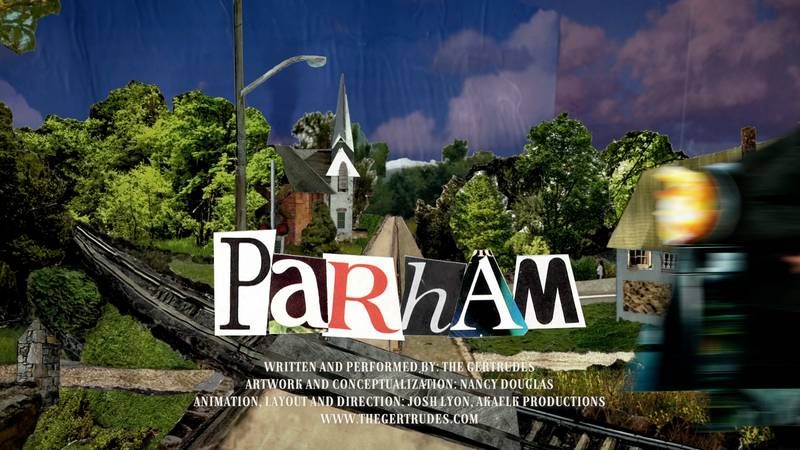Jeff Green | Jun 02, 2021
Greg Tilson is a musician and writer who is part of the Gertrudes, a folk collective based in Kingston.
He has a family cottage near Mississippi Station and drives through Parham several times a summer to get there. When the Parham Fire took place last June, destroying St. James Anglican Church, and a house, which was the former manse of the church, it struck him.
When he saw the burned-out façade of the church, the only thing left standing at the site, it struck him even more.
Reading the accounts of what happened, which included an individual starting a fire behind the house, shooting at neighbours, followed by a large response by the fire, paramedic and police departments to determine the level of danger before attacking the fire, he realised how traumatic the events really were. So he decided to write a song about it and bring it to the Gertrudes
A lot of the work the Gertrudes have been doing is centred around the “shadow pandemic”, issues of homelessness, substance abuse, and mental health in Kingston, and Parham, which is a visceral song about the events that took place on June 7, 2020, fits with the theme, and is part of that larger recording project.
Over the summer of 2020, the song became a project unto itself. Jason Mercer, who lives on Wolfe Islands, came on as a producer. A 19th Century Irish Reel, Rakish Paddy, was used as a base for the music. Along with 6 musicians, (Tilson, Annie Clifford, Matt Rogalsky, Joson Erh, Pete Bowers, and Jason Mercer) many guest musicians were involved, including Georgette Fry, members of the Kingston Symphony and the Open Voices Choir and others.
Nancy Douglas, a collage artist, worked with animator and filmmaker Josh Lyons on a video, which was released to accompany the song.
For Douglas, the impact of the railway on the town became a focus for her visual story telling. When she found out that the church had been moved, along with the manse, in 1912 to make way for railway, it reinforced her decision to use the metaphor of a train that hurtles down the track and through the Parham Crossing, relentlessly through the town, as key element in her video as it is in the song. She used Google Street View to get a sense of the town.
“I'm fascinated by the way people adapt their surroundings to suit their needs; this is what I looked for when making the ‘house portraits’. The buildings in Parham show the evolution of the town and the personalities of the people who live within. The house portraits were made using cut and paste paper collage, careful looking, and Google Street View,” she said in a media statement accompanying the release of the song and video on May 28.
In an interview, Nancy Douglas said that she scanned her collages, which were all done on 8.5 x 11 sheets, and sent them to Lyons to put together.
“I’ve never done animation before, or any video project, and this was a great project for me. I’d love to do more videos. I also loved collaborating on the project with Josh. He was so good at understanding what we talked about when I told him what I was trying to do.”
The video actually looks like Parham, which was important to Douglas.
On the day the song was released, Greg Tilson was interviewed on All in a Day, an afternoon radio show from CBC Ottawa, by host Alan Neil.
The song is available on Band Camp. It costs a dollar to download but there is an opportunity to pay extra and all of the money generated by Parham is being donated the Canadian Mental Health Association.
The song is based entirely on the events of June 7, 2020.
When he talked to the News, Greg Tilson expressed his concern that people are aware of the visceral effect of the words and music in the song, particularly people who live in the vicinity of Parham.
“People should know what they are going to experience before listening to the song and watching the video. It might be upsetting to some viewers.”
Indeed there has been some reaction to “Parham” from locals. Tilson contacted some people with connections to the community before writing the song, including Mayor France Smith, but some of the people who were directly impacted by the events of June 7, 2020, did not know of the existence of the song before it was released on May 28
One person told the News that the song brought back some of trauma of June 7, and wondered why the song did not explore community efforts to come together and heal in the aftermath of the Parham Fire.
“I’d like to have seen the song move to how the community has responded, to end on an uplifting note,” they said.
Parham is available a www.thegertrudes.com
More Stories
- The Sun Shines On The Parham Fair
- Creating Your Own Weather, Forever and Ever
- Silver Lake Pow Wow Set For A Big Year
- South Frontenac Receives Substantial Provincial Grant for their Verona Housing Project
- South Frontenac Council Report - August 12
- Dumping To Be Curtailed At Loughborough Waste Site
- Central Frontenac Inching Towards Increasing Severance Opportunities
- Addington Highlands Council Report - August 12
- Addington Highlands Council Report - August 12
- Addington Highlands Council Report - August 5

